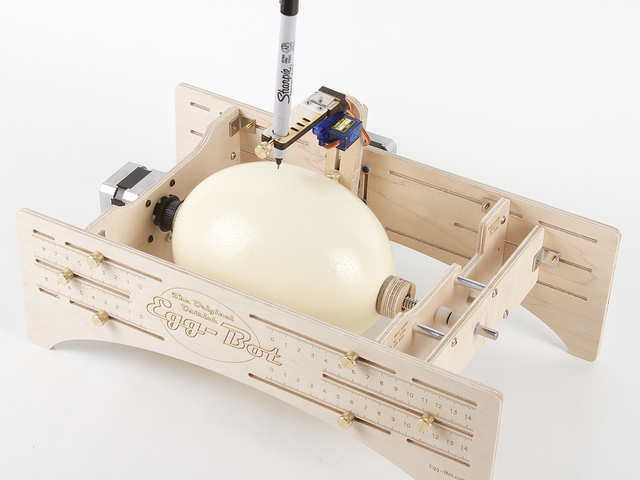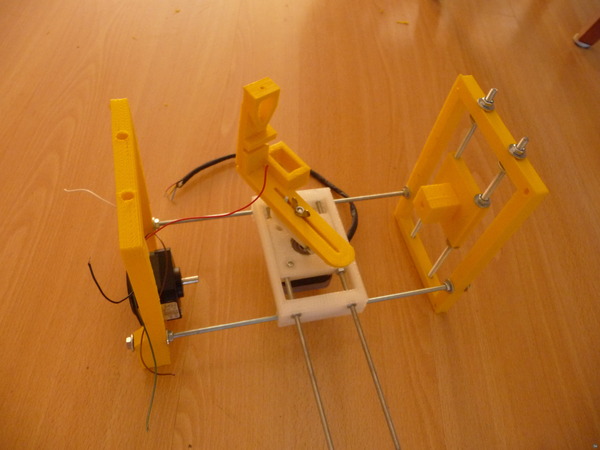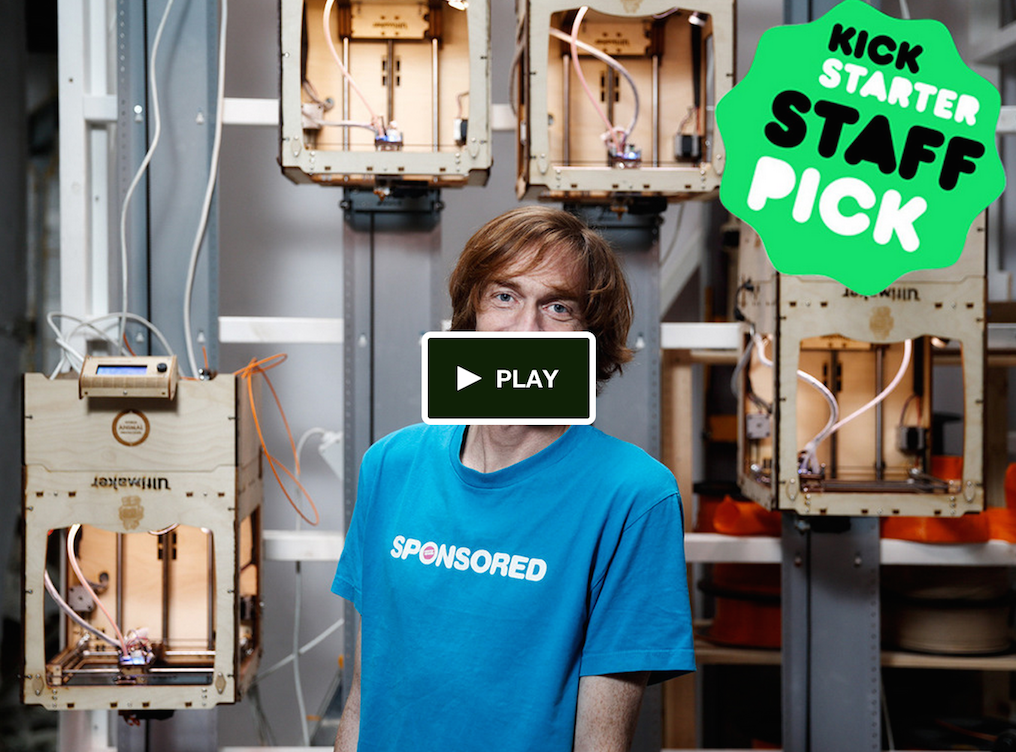With its new Kickstarter Eggbotsz hopes to fund the, ChocoRockoBotto its unique full color chocolate 3D printing technology. The technology developed at Carnegie Mellon University’s Robotics Institute by Professor Willow Yank, hopes to revolutionize the culinary arts. Chocolate 3D printers have been around for a number of years now and are making inroads into high end restaurants and chocolatiers, revolutionizing both chocolate and cooking. Is the full color chocolate Eggbot the device that will bring 3D printing to your kitchen? Two early beta testers have already done head spinning work with the first chocolate 3D printers. Their work indicates that the 3D printing revolution is moving into the kitchen and may change everything.
Brooklyn based artisan organic shade grown single origin chocolate maestro Paul Chichikov of Chocolatier Villages Potemkin for example 3D prints his hand swafted GMO free Easter Ostrich Eggs to the delight of customers from Greenpoint and beyond. Paul, who is a 3D printing evangelist says that in the long weekend that he’s been mastering 3D printing, “it has changed my life. ”
The 3D printed Easter Ostrich Eggs, filled to the brim with Acai berries, bee pollen, wakame & wheat grass cost $190 each and contain 4.8 kilos of the highest quality Kyrgyzstanian Highland chocolate. Paul uses an EggBotsz to 3D print his creations. This Professional Desktop 3D printer is specifically made to 3D print eggs of any type. Until now Chichikov has run into some limitations with 3D printing. “I’ve always said for many years that 3D printing is going to revolutionize the culinary world, but as an urban forager and an artist I felt that 3D printing was holding me back. I want 4D, I want color. I told the Eggbotsz team give me full color and I’ll conquer the world. I believe that the Eggbotsz can make a Croconut-like impact on gastronomy, be something truly revolutionary. ”

The Eggbotsz putting the finishing touches on one of Ms. Jil Ipoya’s award winning culinary delights.
Japanese chef Jil Ipoya uses an Eggbotsz in her 3 Michelin star Spanish Mexican fusion tapas restaurant Pinche Wey in Manhattan. Ms. Ipoya says she, “enjoys the wealth of egg textures and shapes…as well as the design freedom she has when designing her own eggs.” Ms. Ipoya, who is the only Chef to have worked in North America who has not yet been nominated for a James Beard Award, also stated that, “3D printing will play a mayor role in the culinary arts especially in the new wave of post-molecular gastronomy.” “With atomic gastronomy chef’s creations can become even more contrived & recondite with menus hopefully becoming more akin to deadal worded technical manuals that bring true culinary fission to the table.” Ms. Ipoya, who has experimented with 3D printing scrambled & even poached eggs, uses the technology for 6 courses on her 158 course, Signature Tasting Menu with each course served either intravenously or in a pipette.
One of her most popular dishes, Muff & Min, is entirely 3D printed. The deconstructed Egg McMuffin inspired dish uses an Earl Grey infused essence of Jidori Hen terrine on Bresse egg souffle set in zest of King Crab served on a foam of sous vide sourdough wrapped in dedain and artifice with a side of liquid nitrogen spheres and granular distillate of brine. The dish is served in a shot glass hanging from a small drone to mimic man’s hunter gatherer past. Diners pursue the drone through the restaurant and once they either tire or catch it, down the shot while standing on one leg holding a ping pong paddle as wait staff fire white roses at them from Nerf guns. The New York Times called the dish “a revelation….clearly Ms. Jil Ipoya is breaking new ground in fine dining. Ms. Ipoya is truly one of the hottest chefs in lower Manhattan and her cooking is not bad either.” To reconnect with nature diners are also encouraged to pick their own eggs, forage for food in the dumpsters of neighboring restaurants as well as use a compound bow to hunt for deer in Central Park. Ms. Ipoya was searching for a clearer way to distinguish herself from her peers thinks that 3D Printing her eggs, in color, may be the way to do it.
The Invention of Full Color Chocolate 3D Printing
Across the Redheffer quad at CMU there stands an old dilapidated building used for nuclear frisson testing in the 1950’s and long since abandoned. Professor Yank along with her students Wǒ Kào & Kono Yarou has worked here for 3 years in complete secrecy on full color chocolate 3D printing. The Lamarck House, is a desolate place, with upturned desks, dust covered scientific equipment and ytwokay bugs scurrying back and forth. Here the team had little contact with other CMU students and staff. They worked long hours perfecting their full color 3D printing technique, living on ramen and hope.
For one and a half years the team struggled to get their U axis and V axis under control. U and V axis control being one of the most essential elements to high dimensional flavor-ability in 3D printing chocolate. If they couldn’t get the dimensional flavor-ability right the team could not obtain a high Choxels Per Inch. CPI is the key Key Performance Indicator for the chocolate 3D printing industry. According to a recent research report by Ranger, CPI rates in new chocolate 3D printers are accelerating with newer systems having CPIs in the range of 9 to 11. “It was always going to be about CPI for us, Choxels Per Inch is the challenge in our industry and if would be able to develop an ultra high CPI technology, we’d be able to put a chocolate 3D printer on every kitchen-table”, says Professor Yank. The Chocolate 3D Printing Industry is set to grow by 78% to $6.4 billion by Tuesday according to a recent report by research firm Yard.

Graph by boutique investment house Wing & Prayer illustrating the explosive growth in chocolate 3D printing
Industry giants such as Chock Fill A have a big lead over new entrants with an entire line of chocolate 3D printers for home and industrial use. Other start ups such as Colorado based Hanky, makers of the iconic red and white striped 3D Chocolate Printing pen, are also forging ahead. Professor Yank knew there was an opportunity out there to create a revolutionary new chocolate 3D printing technology that was completely new and revolutionary. Hanky & Chock Fill A still relied on old 3D printing technology from ancient 3D printers that have been used since they were developed during early nineties for the Meiji Restoration of Tokyu Hands, the largest department store in Japan. Not many know that Japanese inventor Professor Kuso Kurae originally invented 3D printing in order to make exquisite wall decorations for the iconic Tokio department store. From such comparatively humble beginnings this world changing technology has now blossomed. Yank knew, that invention was the path forward and only by creating a true chocolate 3D printing revolution and developing better technology they would succeed.
Other chocolate 3D printers use stepper motors to power their axes. These stepper motors spin counterclockwise in a brownian motion propelling solid magnets in a vacuum. Standard on almost all 3D printers the team had tried to adapt them for use in their full color chocolate 3D printing technology. Without the needed U and V axes control however their results were disappointing. Rather than 3D printing Yoda dolls or other useful 3D printed objects, everything melted immediately.
Without adequate U & V control the team would never achieve high dimensional flavor-ability and their ground breaking project was doomed. A further issue was with the heated bed. 3D printers deposit their material on a heated build platform, also called a bed in the industry. Due to the choco solid degradation and bad U & V control, the team had what is called in the industry an “unmade bed”, disastrous out of the box print results. Because chocolate has to be tempered in order to print properly temperature control of the bed was another crucial element. The team had been using sine heat systems to temper the chocolate but the results were atrocious lacking any dimensional technobility and superforce. With funding running out the team shared many sleepless nights. Professor Yank begged the iron willed university administration for more funding but it seemed that the project would be cancelled. Kono Yarou’s studious discovery saved the day. Kono Yarou is a studious and dedicated Social Engineer who reads journals such as 4D Printing & Free Form Fabrication in Gastronomy recreatively. The 23 year old Japanese student has large round eyes and a rather surprised expression on his face as well as a shock of blonde hair. In his spare time he’s often seen wandering the tree lined Italianate CMU campus with a journal in hand. During one of these walks, in an obscure engineering journal, he happened to come across a paper by a Dutch team from Zwaffelen University.

A diagram explaining Eggbot’s revolutionary 3D printing technology, Zwaffelen University’s Macrocontroller is shown in yellow to the right The heated bed is shown in light green. The U axis is grey and the V axis is dark green.
The team had developed a method for making a macrocontroller for cosign heating. With limited applications the technology had not attracted attention. Yarou noticed however that the Dutch team’s controller worked at temperatures of 100 and 130 Kelvin, perfect for tempering chocolate. Armed with this information the received two NSF grants as well as $1.8 million in funding from America Makes. This let them commercialize Zwaffelen University’s macrocontroller and for the first time adequately temper chocolate inside a 3D printer. Another breakthrough occurred when Wǒ Kào, a 23 year old Dianetics major from Shén Jīng Bìng, China disassembled a stepper motor in order to reverse engineer it. She found that by reversing the polarity of the magnets inside the motor and applying Van der Waals forces to the resulting magnet she could achieve the superior U & V control needed for full color chocolate 3D Printing. The team then went on to develop their Continuous Line Inference Traversing 3D printing technology. After perfecting their invention they partnered with Eggbotsz to bring it to market.

The Eggbotsz putting the finishing touches on one of Ms. Jil Ipoya’s award winning culinary delights.
The Future of Everything
Eggbotsz co-founder Henry Gondorff explains that whilst 3D printed eggs are poised to take over the culinary world but that, “people all want to full color 3D print chocolate.” “We could already 3D print duck eggs, century eggs and chicken eggs, but so far full color was beyond humanity’s grasp.” “We were amazed at the capabilities of the CMU team’s technology and we think that full color chocolate 3D printing of eggs is a culinary revolution set to revolutionize the 3D Printing revolution. This revolution in a revolution will revolutionize everything bringing with it revolutionary applications for this game changing technology that will empower revolutionaries in their own revolutions. Full color 3D chocolate egg printing is set to make a bigger impact on the world than any other technology ever has.”
The new Eggbotsz ChocoRockoBotto is capable of 3D printing 24 million colors in true full color at a 1080p HD resolution. The bidirectional multi-piezo print head of the Eggbotsz moves at a speed of 240 FPS at 640 Choxels. At this level of Choxels the chocolate doesn’t coat the individual taste buds like regular non-3D printed chocolate does but rather blanket the tastebuds in a Moroni Defined Matrix. This non euclidian structure allows for more depth of flavor. The Eggbotsz also has a dimensional accuracy of 4 and a XY positioning accuracy of 2m. The Interior Wall Volume height of the 3D printer is 11 MHz and the layer thickness of the printer is .000005 micron. The 3D printer has a build volume of 50 by 50 by 50 cm, which is perfect for even very large eggs or batches of dozens of eggs at a time. We think that this 3D printer is an amazing piece of work and can’t wait to see it come to kitchens everywhere! Competition is already springing up worldwide however with Dutch Designer Karijn Wessing designing an open source eggbot which is almost entirely 3D printable. It is truly an exciting time to be alive!
Creative Commons Attribution, Creative Commons Attribution, Creative Commons Attribution, Creative Commons Attribution.















